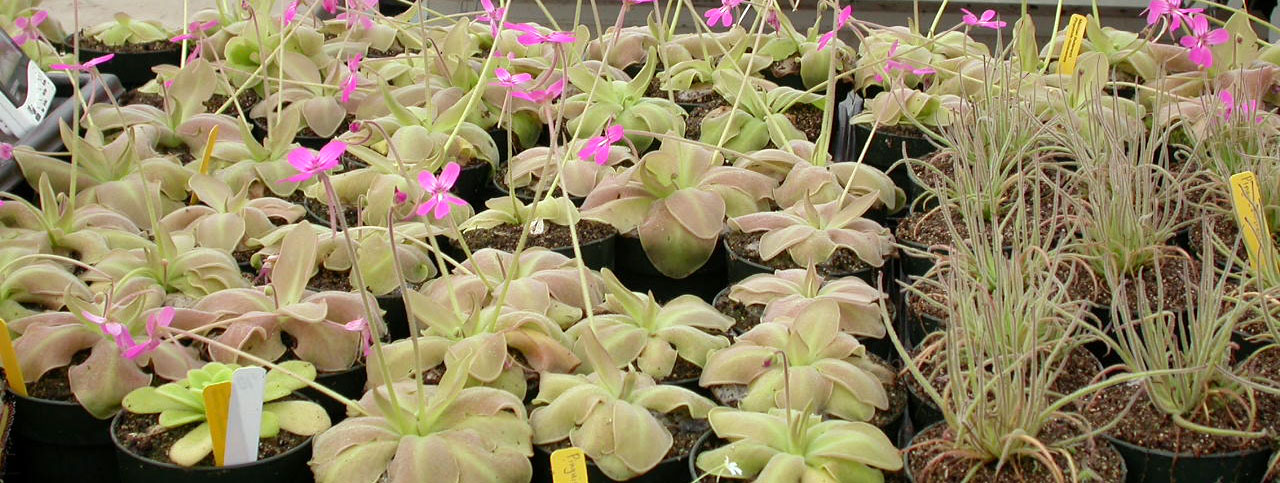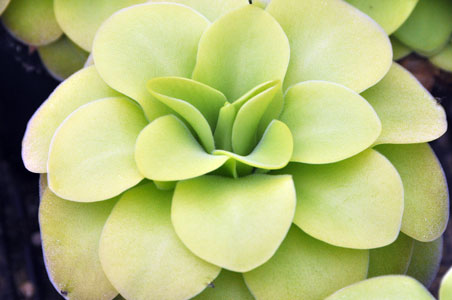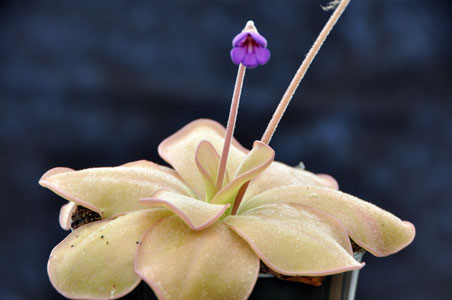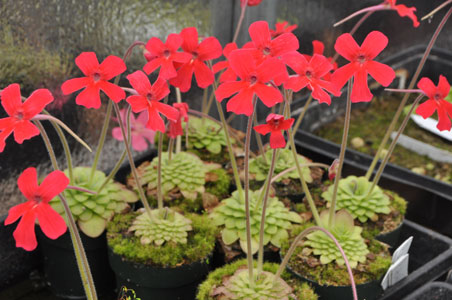Tropical Butterwort Care
Get the straight facts from guys who grow and propagate thousands of carnivorous plants every year.

The tropical butterworts hail from south-central Mexico, the center of their diversity. Many are also natives of the Caribbean islands, Central America,
and subtropical regions of Florida, with a smattering of species in South America. They come in all shapes and sizes.
Some varieties grow as rosettes of broad leaves over half a foot across, while others are barely an inch wide.
Some of the rarer ones have long, narrow, upright leaves, which make them look more like sundews than butterworts.
Their variety is astounding, linked by the common theme of conspicuous, orchid-like flowers.
Each variety, species, and hybrid has its own distinctive flower.
If you’ve successfully grown tropical sundews or Nepenthes, you will enjoy growingPinguicula. They have slightly different care requirements than most other carnivorous plants, so if you’re new to carnivorous plants, gain some experience with some others first. Read The Ultimate Carnivorous Plant Guide for Beginners to learn more about growing the more common plants in cultivation. Tropical Pinguicula have just enough quirks that make them somewhat less forgiving than a tropical sundew or a Nepenthes.



Where to Grow
Grow your tropical butterworts indoors on a sunny windowsill. They appreciate a mild ambient climate, which is why they tend to do exceptionally well for coastal growers. A cool windowsill (between 60-75 deg. F., 15-25 deg. C.) will encourage lush growth as long as they also receive enough sunlight. Humidity is a non-issue - most tropical butterworts appreciate damp soil but too much ambient humidity can cause rot.
Sunlight
Grow your tropical butterwort in direct morning sun and dappled sun during the rest of the day. Avoid the blazing hot afternoon sun during the summer months - this will stress tropical
Pinguicula and could cause them to shrink in size.
Artificial Lights
If a sunny window is not possible, use strong fluorescent lights (a minimum of 40 watts in actual output). Start with the lights approximately 12 inches above your plant. Monitor your butterwort's adjustment by watching how healthy any new growth appears, and adjust the height of the light source if you are not satisfied with its growth. Use an electrical timer to maintain consistent daylight hours (14 hours is sufficient throughout the year).
Water
Unlike most other carnivorous plants, tropical butterworts are prone to rotting if the soil is too wet. Keep the soil moist by top watering whenever the top soil begins to feel dry. It's alright to pour water over your plant! Mucilage washed off the leaves will be replaced within the day. Avoid letting the soil dry out completely.
If you prefer, you may keep your plant in small amounts of water, no more than 1/4 of the way up the pot. If you use this method of watering, add more water only when the water evaporates completely from your tray.
Soil
Use a coarse mix of one part sphagnum peat and two parts perlite. Never use potting soil or fertilizer; they will kill your plant.
Winter Growth
Tropical butterworts will produce a tight rosette of smaller succulent-like leaves during winter when days become shorter and temperatures cool down. This type of formation is the plants' way of adapting to winter drought in the wild. They will resume regular growth after a few months.

THE ULTIMATE CARNIVOROUS PLANT GUIDE FOR BEGINNERS
In this downloadable ebook, Jacob Farin, co-owner of Sarracenia Northwest, will show you how to think like a professional carnivorous plant grower and keep your first carnivorous plant alive and healthy. You will learn:
- how sunlight and water affect plant growth.
- what type of soil and pots to use.
- if you really need to shelter your plants from snow and ice.
- how to troubleshoot common plant problems.
If you are new to carnivorous plants or have struggled to keep them alive, this ebook is for you. Download your copy today!
